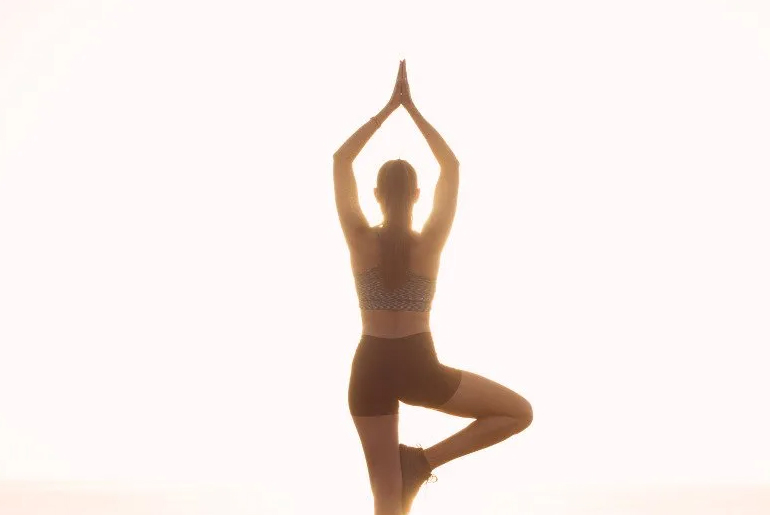Hyperuricemia, or elevated uric acid, can be uncomfortable and result in kidney stones and gout. Certain yoga positions can enhance medical treatment by promoting the body’s natural detoxifying processes and enhancing circulation, even though medication is still necessary for addressing these problems. Pose types that assist stimulate the kidneys, enhance digestion, and encourage the body to rid itself of excess uric acid include Ardha Matsyendrasana (Half Spinal Twist), Bhujangasana (Cobra Pose), Pawanmuktasana (Wind-Relieving Pose), and Setu Bandhasana (Bridge Pose). Regularly performing these poses in addition to taking prescribed drugs can improve general health and help control uric acid levels.
1. Triangle Pose, or Trikonasana
Trikonasana is a standing pose that stimulates the abdominal organs and extends and strengthens the legs, spine, and hips.
- This pose helps the kidneys filter out excess uric acid by improving blood circulation, particularly in the lower body and abdominal area.
- By stimulating the digestive organs, it improves metabolism and facilitates the breakdown of compounds high in purines, which are a major source of uric acid.
- Additionally, it increases general flexibility and decreases stiffness, which may help people with gout or joint pain brought on by elevated uric acid levels.
2. The Cobra Pose, or Bhujangasana
The backbend known as bhujangasana opens out the chest, lungs, and abdomen while strengthening the spine.
- The kidneys and adrenal glands are stimulated in this pose, which improves their function and helps with detoxification.
- It eases constipation and encourages improved digestion, both of which are critical for controlling uric acid accumulation.
- One of the main symptoms of elevated uric acid, particularly in gout sufferers, is inflammation, which can be lessened with regular practice.
3. The Wind-Relieving Pose, or Pawanmuktasana
The supine pose known as Pawanmuktasana emphasizes the digestive system and the release of toxins and gas.
- By gently massaging the abdomen, it improves digestion and efficiently gets rid of metabolic waste.
- The liver and kidneys, the main organs in charge of removing uric acid, are less taxed as a result of this enhanced clearance.
- It is especially beneficial for those with gout or high uric acid because it also promotes renal function, stimulates the colon, and reduces bloating.
4. The Half Spinal Twist Pose, or Ardha Matsyendrasana
Ardha Matsyendrasana is a seated twist that enhances spinal flexibility and massages the abdominal organs.
- The twisting action detoxifies the liver and kidneys by stimulating their function, aiding in the breakdown and excretion of uric acid.
- It also improves digestion and nutrient absorption, both of which are important in managing purine metabolism.
- This pose also helps in flushing out toxins and balancing energy, contributing to overall metabolic health.
5. The Corpse Pose, or Shavasana
The restorative pose known as Shavasana is performed to encourage profound relaxation and healing.
- Because persistent stress can exacerbate metabolic problems and inflammation, it lowers cortisol levels and stress, which can positively affect uric acid levels.
- This posture promotes parasympathetic nervous system activity, aids in internal healing and detoxification, and lets the body absorb the benefits of the previous asanas.
- Shavasana also enhances the quality of sleep, and getting enough sleep is essential for preserving metabolic and hormonal balance, including the control of uric acid.
Conclusion
Together, these five yoga positions create a comprehensive sequence that:
- stimulates the kidneys and digestive tract
- improves blood flow and cleansing
- lowers stress and inflammation
- aids in the body’s natural removal of uric acid.
Use these under supervision every day for best results, along with a low-purine diet and plenty of water to avoid uric acid accumulation.
Would you like a daily yoga sequence plan that uses these poses to regulate your uric acid?
Disclaimer:
The information contained in this article is for educational and informational purposes only and is not intended as a health advice. We would ask you to consult a qualified professional or medical expert to gain additional knowledge before you choose to consume any product or perform any exercise.







